Contents
Review of 6 Best Medical AI Annotation Tools for DICOM
Encord DICOM
3D Slicer
Labelbox
Kili
ITK-Snap
MONAI
DICOM Annotation Tools: Key Takeaways
Encord Blog
Best DICOM Labeling Tools [2024 Review]

The FDA has approved over 300 AI algorithms over the last 4 years – the vast majority of which relate to medical imaging.
With the increase in medical AI and computer vision applications, healthcare teams are turning to AI models for more accurate and faster diagnosis at scale.
A correct or incorrect diagnosis impacts treatment, care plans, and outcomes. And ultimately, computer vision and machine learning applications across medical AI have the potential to materially impact the chances of a positive outcome.
And as we know, it all starts with data. Getting a radiology AI product to market – not to mention through FDA or CE clearance – starts with data quality and speed, which in turn relies heavily on accurate annotation and labels, whether the images come from CT, X-ray, PET, ultrasound, or MRI scans.
To help you navigate all the DICOM labeling tools and frameworks on the market, we have compiled a list of the most popular annotation tools for annotating DICOM and NIfTI files.
Whether you are:
- A data science team at a fast-growing radiology AI startup trying to bring your first products to market or obtain FDA approval
- A data operations team at a large healthcare organization evaluating medical imaging tools to help your team analyze CT scans and MRI scans
- ...or a computer vision team at a healthcare provider or vendor delivering high-value machine learning-based solutions for hospitals, doctors, and other medical professionals.
This guide will help you compare the top tools to annotate DICOM and NIfTI files and help you find the right one for you.
We will compare them across a few key features – collaboration, quality control (QC) and quality assurance (QA), and ease of use for annotators and medical data operations managers. If you’re evaluating NIfTI labeling tools, you can find more about the key features you need to look out for here.
So let’s get into it! In this post, we’ll cover six of the most popular AI-based medical image annotation tools:
Review of 6 Best Medical AI Annotation Tools for DICOM
Encord DICOM
Encord is the leading DICOM annotation platform trusted by leading medical AI teams at healthcare institutions.
Encord’s AI-based annotation tool was purpose-built in close collaboration with healthcare teams for machine learning and computer vision projects in the medical profession. Encord and Encord Active are designed to handle vast medical image and video-based datasets (e.g. surgical video), alongside DICOM, NIfTI and +25 other data formats.
Benefits & Key features:
- Native DICOM rendering: Render 20,000+ pixel intensities natively in the browser with a PACS-style interface.
- 3D views: Multiplanar reconstruction (axial, coronal, and sagittal views) and maximum intensity projection (MIP).
- Windowing support: Preset window settings for numerous modalities and the most common objects that need detecting, identifying, and annotating (e.g., lung, bone, heart, brain, etc.).
- Hanging protocols support: For Mammography, CT and MRI.
- Expert review workflows: Collaborative workflows designed for medical teams and scalable data operations.
- Foundation models support: Generate mask predictions with our AI-based auto-segment tool.
- Configurable labeling protocols: Create complex medical labels and protocols to train your annotation team with our medical-grade annotation tool.
- Support for multiple annotation types: Bounding boxes, polygons, segmentation, polylines, keypoints, object primitives, and classification.
Best for: Teams rolling out new healthcare AI models, computer vision DataOps teams, annotation providers, ML engineers, and data scientists in medical organizations.
Pricing: Free trial model and simple per-user pricing after that.
💡 More insights on labeling DICOM with Encord:
Here are some examples of healthcare and medical imaging projects that Encord has been used for:
- Floy, a radiology AI company that helps radiologists detect critical incidental findings in medical images, reduces CT & MRI annotation time with AI-assisted labeling.
- RapidAI reduced MRI and CT annotation time by 70% using Encord for AI-assisted labeling.
- Stanford Medicine cut experiment duration time from 21 to 4 days while processing 3x the number of images in 1 platform rather than 3
Further reading:
- Best Practice for Annotating DICOM and NIfTI Files
- The 7 Features to Look Out For When Choosing a DICOM Annotation Tool

3D Slicer
3D Slicer is an open-source software application designed for medical image processing and visualization. It provides a platform for 3D image segmentation and registration. The US The National Institutes of Health (NIH) and other healthcare partners have played an important role in funding 3D Slicer, alongside Harvard Medical School, and dozens of other public and private funding sources.
There have been numerous contributors to 3D Slicer, with an active community improving the source code, architecture, building modules, securing funding, and citing 3D slicer in medical computer vision and machine learning model training experiments and development.

Benefits & Key features:
- Easy (& free) to get started labeling DICOM files.
- Great for manual data annotation — also supports semi-assisted labeling.
- Robust ground-level annotation capabilities (including classification and object detection) for a broad set of computer vision use cases.
Best for: Students, researchers, and academics testing the waters with DICOM annotation (perhaps with a few files or a small open-source medical imaging dataset).
Pricing: Free!
💡 More insights on image labeling with 3D Slicer:
If your team is looking for a free annotation tool, you should know… 3D Slicer is one of the most popular open-source tools in the space, with over 1.2 million downloads since it was launched in 2011.
Other popular free image annotation alternatives to 3D Slicer are CVAT, ITK-Snap, MITK Workbench, HOROS, OsiriX, MONAI and OHIF Viewer.
If data security is a requirement for your annotation project… Commercial labeling tools will most likely be a better fit — as key security features like audit trails, encryption, SSO, and generally-required vendor certifications (like SOC2, HIPAA, FDA, and GDPR) are not available in open-source tools.
Further reading:
- Buy vs build for computer vision annotation - what's better?
- Overview of open-source annotation tools for computer vision
Labelbox
Labelbox is a US-based data annotation platform founded in 2018, after the founders experienced the difficulties associated with building in-house ML operations tools. Like most of the other platforms mentioned in this guide, Labelbox offers both an image labeling platform, as well as labeling services.
Teams can annotate a wide range of data types (PDF, audio, images, videos, and more) using the Labelbox data engine that can be configured for numerous ML, AI, and computer vision use cases.
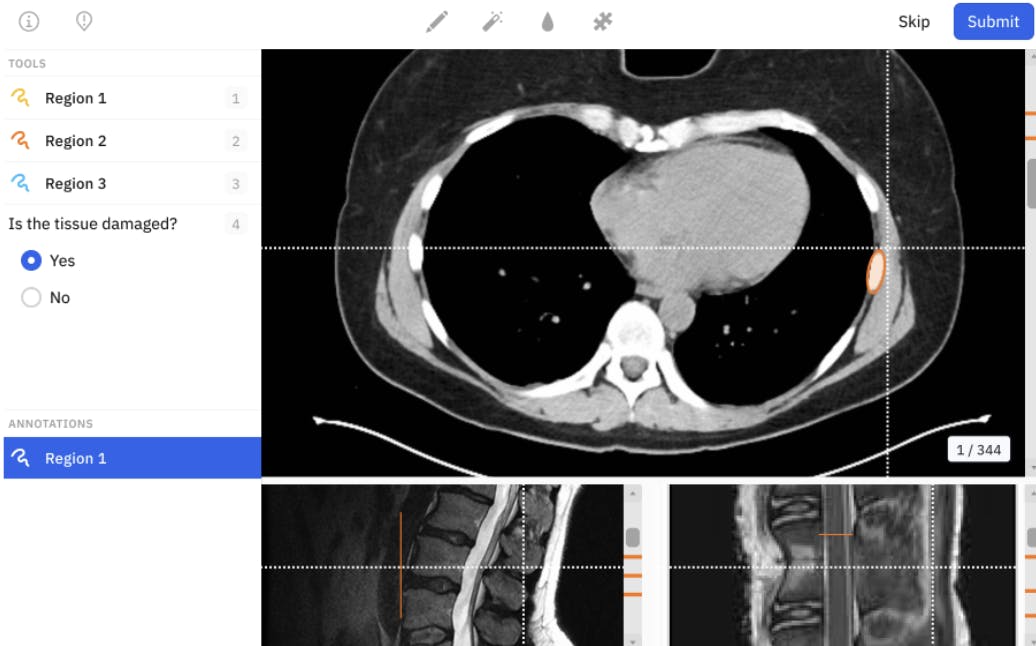
Benefits & Key features:
- Support for two annotation types – polyline and segmentation – and common imaging modalities – CT, MRI, and ultrasound.
- SaaS or on-premise workflows with privacy and security built-into the platform.
- Catalog view to help medical annotation teams label and sift and find patterns within vast multi-format datasets.
Best for: Teams wanting to annotate other file formats alongside DICOM, like documents, video, text, audio, and PDFs.
Pricing: 10,000 free LBUs to begin with, and custom pricing beyond that.
💡 More insights on labeling DICOM with Labelbox:
If your team is looking for on-demand labeling services, you should know… Labelbox can connect your in-house team with outsourcing partners for large ML annotation projects.
If data security is a requirement for your annotation project… Labelbox comes with enterprise-grade security as standard for healthcare and AI teams.
Further reading:
Kili
Kili is a data annotation platform founded in 2018 by a French team who had previously built the AI company, MyElefant, and an AI lab from scratch for BNP Paribas. The platform allows users to create and manage annotation projects, monitor progress, and collaborate with team members in real time. Kili has been used by businesses across various industries, including healthcare, finance, and retail, to accelerate their AI development.
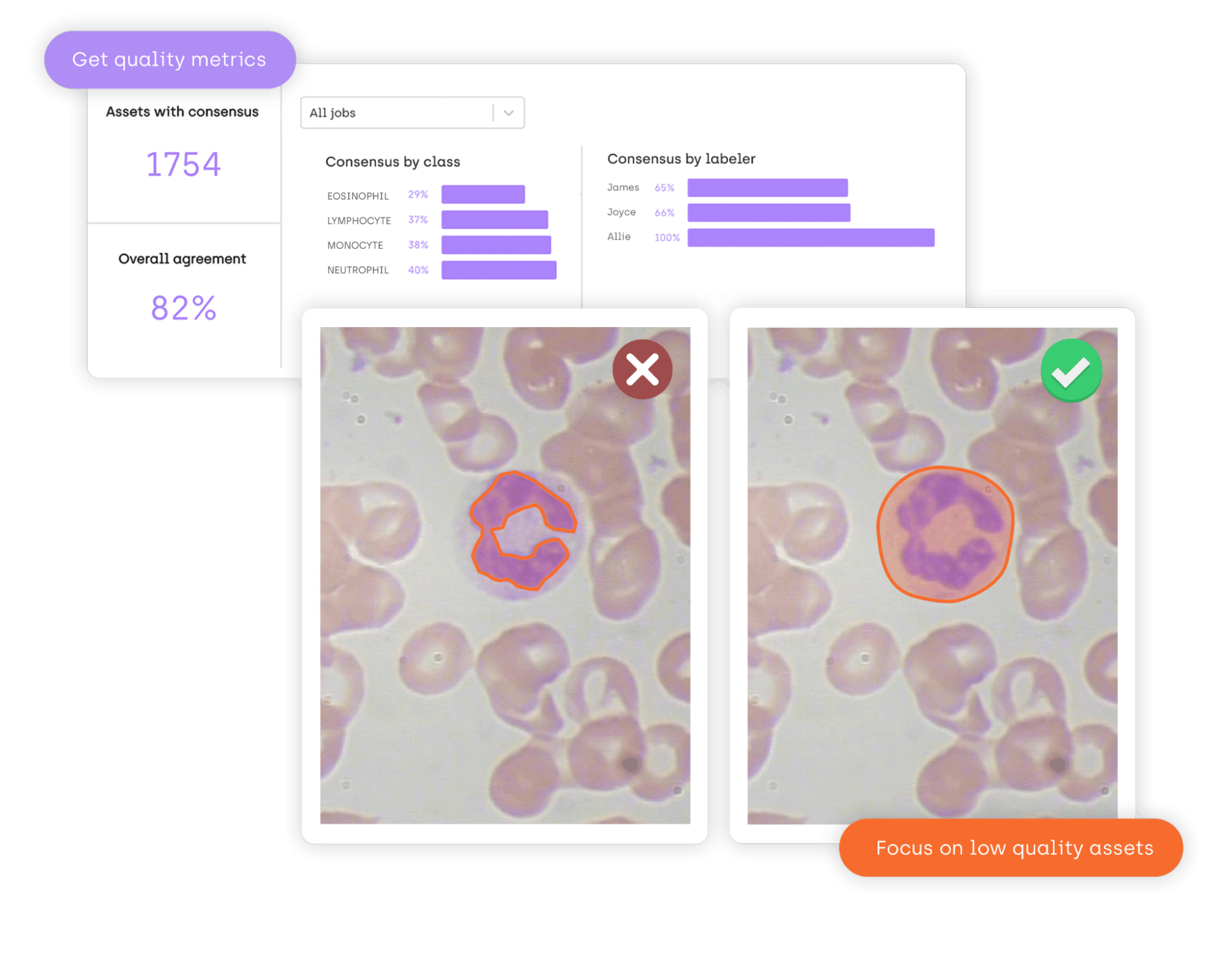
Benefits & Key features:
- Support for multiple annotation types, including text, image, video, and audio.
- A platform designed to label, find, and fix data annotation issues and simplify DataOps for AI teams of every size.
- For small-scale projects, DataOps can implement Kili with 5 lines of code to turn a machine learning workflow into a data-centric AI workflow.
Best for: ML and DataOps teams across a range of sectors, either with in-house or outsourced teams.
Pricing: Free tier for individuals, alongside corporate and enterprise plans for businesses.
💡 More insights on labeling DICOM with Kili:
If your team is looking for an easy-to-integrate ML tool, you should know… Kili was designed to embed into ML workflows easily – it doesn’t have as many features as some computer vision SaaS products, but it integrates rapidly in a wide range of data tech stacks.
Further reading:
ITK-Snap
ITK-Snap is a free, open-source, multi-platform software application used for image segmentation. ITK-Snap provides semi-automatic segmentation using active contour methods as well as manual delineation and image navigation.
ITK-Snap was originally developed by a team of students at the University of North Carolina led by Guido Gerig (NYU Tanden School of Engineering) in 2004. Since then, it’s evolved considerably, now being overseen by Paul Yushkevich, Jilei Hao, Alison Pouch, Sadhana Ravikumar and other researchers at the Penn Image Computing and Science Laboratory (PICSL) at the University of Pennsylvania. The latest version, ITK-Snap 4.0, was released in 2020, funded by a grant from the Chan-Zuckerberg Initiative.
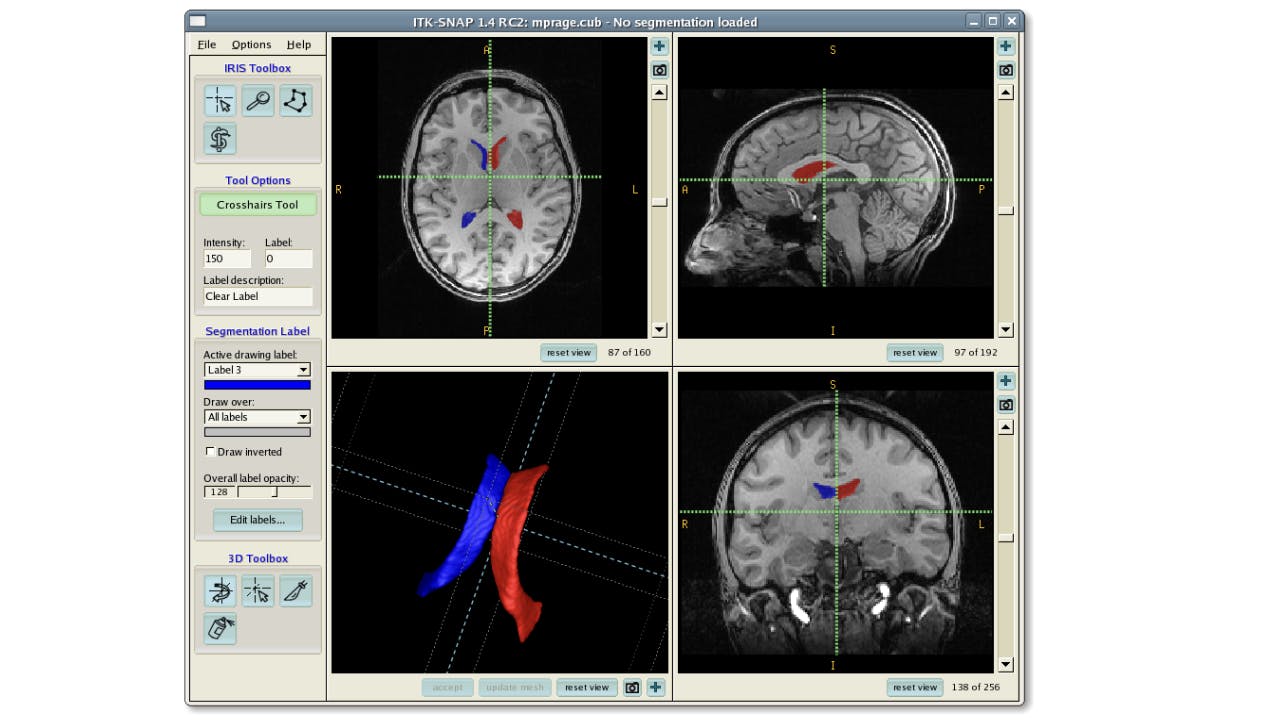
Benefits & Key features:
- Manual segmentation in three planes.
- Support for additional 3D and 4D image formats alongside DICOM, like NIfTI.
- A 3D cut-plane tool for faster processing of image segmentation results and multiple images, including an advanced distributed segmentation service (DSS).
Best for: Medical image annotation, students, and research teams.
Pricing: Free!
Further reading:
- 9 Best Image Annotation Tools for Computer Vision [2024 Review]
- The Top 6 Artificial Intelligence Healthcare Trends of 2024
MONAI
MONAI is an open-source, PyTorch-based framework designed for deep learning in medical imaging. The project was started in 2019 by NVIDIA, the National Institutes of Health (NIH), and other contributors. The framework provides various tools, including a labeling tool, to assist in the creation of annotated datasets for training deep learning models.
MONAI’s labeling tool allows users to annotate images with 2D or 3D bounding boxes, segmentation masks, and points. The annotations can be saved in a variety of formats and easily integrated into the MONAI pipeline for training and evaluation. MONAI has gained popularity due to its ease of use and its ability to accelerate research in medical imaging.
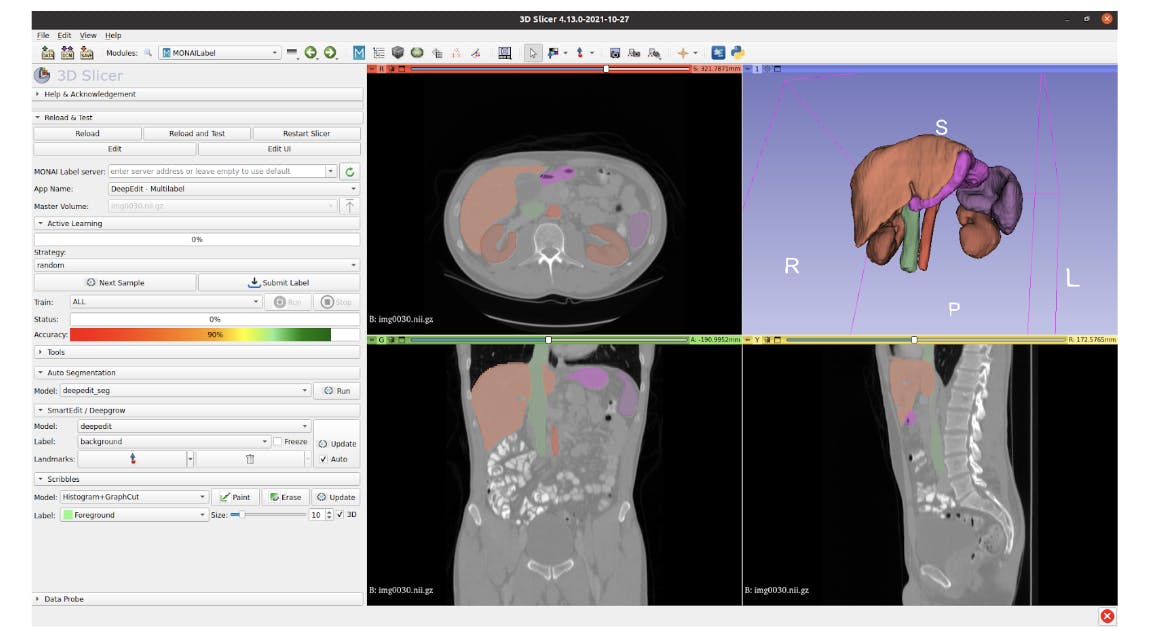
Benefits & Key features:
- Easy (& free) to get started labeling biomedical and healthcare images with the MONAI Label Server.
- Capabilities for training AI models for healthcare imaging across a range of modalities and medical specialisms with two transformer-based architectures.
- Convenient integrations through the MONAI Deploy App SDK.
Best for: Medical imaging, annotation, and research teams that need an open-source healthcare AI platform.
Pricing: Free!
💡 More insights on labeling DICOM with MONAI:
If your team is looking for an open-source alternative to commercial tools, you should know… MONAI is designed as an AI-based collaborative platform with a suite of features you can host and deploy in a wide range of medical environments.
If data security is a requirement for your annotation project… MONAI is better equipped than most open-source medical imaging projects with layers of enterprise-grade security.
Further reading:
- 7 Ways to Improve Medical Imaging Dataset
- Guide to Experiments for Medical Imaging in Machine Learning
DICOM Annotation Tools: Key Takeaways
There you have it! The 6 most popular annotation tools for annotating DICOM.
For further reading, you might also want to check out a few honorable mentions, both paid and free annotation tools:
- Hive: Cloud-based AI tools for organizations that need to apply labels across a wide range of data types
- Dataloop: Software to train and improve ML and AI models with extensive annotation capabilities
- Appen: One of the oldest labeling services platforms on the market, launched in 1996
- VOTT: An open-source tool with tags and asset export features compatible with Tensorflow and the YOLO format.
Ready to improve the accuracy, outputs, and speed to get your healthcare AI models production-ready with DICOM annotations?
Sign-up for an Encord Free Trial: The Active Learning Platform for Computer Vision, used by the world’s leading computer vision teams.
AI-assisted labeling, model training & diagnostics, find & fix dataset errors and biases, all in one collaborative active learning platform, to get to production AI faster. Try Encord for Free Today.
Want to stay updated?
- Follow us on Twitter and LinkedIn for more content on computer vision, training data, and active learning.
- Join our Discord channel to chat and connect.

Power your AI models with the right data
Automate your data curation, annotation and label validation workflows.
Get startedWritten by

Dr. Andreas Heindl
Explore our products
